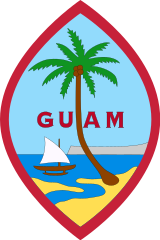
This is a list of Guam territorial symbols:
| Type | Symbol | Year | Image |
|---|---|---|---|
| Flag | The Flag of Guam | February 9, 1948 |  |
| Seal | The Seal of Guam | 1946 |  |
| Nickname | Nicknames: | ||
| Song | "Stand Ye Guamanians" | 1919 | |
| Bird | Guam rail |  | |
| Flower | Bougainvillea spectabilis [3] | 1968 |  |
| Quarter | Quarter of Guam | May 26, 2009 |  |
| License Plate | License Plate of Guam | 2009 | |
| Tree | Intsia bijuga | 1969 |  |
